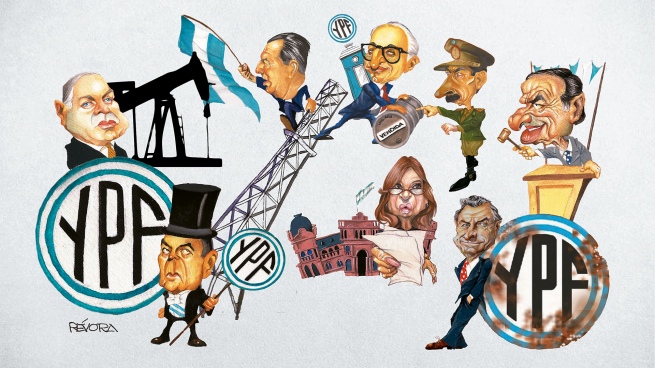Oil for the thriving automotive industry. Oil for industry. Oil for national development. Oil for the people, for work, so that what was insinuated could be born. Oil for peace and for war. Petroleum. The black gold that at the beginning of the 20th century sprouts from the bowels of Argentina awakens its own dreams and those of others.
The antecedents of Yacimientos Petroliferos Fiscales (YPF) must be found in the first decade of the 20th century and in the discovery of oil in the vicinity of the Patagonian city of Comodoro Rivadavia.
This attracted the first foreign companies looking for the oil that would allow them to supply fuel to the automobile market, whose expansion was booming. The world was coming out of the Great War and was preparing, even without knowing it, for the Second World War.
Oil was considered a strategic asset for nations. Thus, the General Directorate of Petroleum Exploitation was created. The objective of this first national state entity was precisely to regulate the activity of multinational companies that were gradually establishing themselves in the country.
But it will be at June 3, 1922with Hipólito Yrigoyen still in the Presidency of the Nation, that the General Directorate of Fiscal Petroleum Deposits will be created by decree, the first step of the flag oil company.
On October 19 of the same year, a few days after arriving at the Casa Rosada Marcelo Torcuato de Alvear, Enrique Mosconi will be appointed CEO of YPF. Military and engineer, Mosconi was in charge of the company for eight years to make it the first vertically integrated state oil company in the world.
A radical Irigoyenist, Mosconi considered it “inexplicable” to grant foreign capital oil exploration and exploitation instead of reserving “such benefits to increase the moral and material well-being of the Argentine people.” “Handing over our oil is like handing over our flag”he emphasized.
An oil company, a country

Since its inception, YPF will carry out all the activities necessary for the exploitation of oil, relegating powerful foreign companies such as Shell and Esso to the background.
In addition, the work of the company would report resources to the national State for the development of the country and would give the Nation a fundamental charter to exercise its sovereignty.
Along with the state exploitation of oil, towns were born and grew throughout the country. Comodoro Rivadavia, Las Heras, Cañadón Seco, Caleta Olivia and Plaza Huincul are just some of them.
On February 22, 1923, YPF inaugurated the first kerosene pump in Buenos Aires.. Three months later these numbered seven. On June 20 of the same year, the first gasoline pump for vehicles was built.
However, the first cycle of the company would come to an end with the 1930 Coup d’état, where the military led by José Félix Uriburu and Agustín P. Justo would inaugurate the Infamous Decade, just before the National Congress approved the nationalization of oil promoted by Yrigoyenism.
Yrigoyen would be confined on Isla Martín García and Mosconi arrested, upon delivery of the YPF facilities. Among the reasons for the coup that would inaugurate the interruptions of the constitutional order that Argentina suffered during much of the 20th century was the oil policy.
It is that the radical government was about to sign an agreement with the then Soviet Union in which the oil activity promoted by YPF had a leading role. Without such an agreement, the way was cleared for American and English capital.
The road to the Argentine oil company
• YPF’s background they must be found in a decree dated December 14, 1907, the day after the first drilling was carried out in the vicinity of Comodoro Rivadavia and which produced Argentine oil in a volume of ten cubic meters.
• The decree signed by President José Figueroa Alcorta he laid the foundations for a national oil policy, aware of the importance that oil would have and that excluded private exploitation.
• Between 1908 and 1910 five wells were drilled, which produced gas and oil. In this last year, the first reserve law of some 5,000 hectares was enacted in Comodoro Rivadavia.
• Roque Sáenz Peña rejected a proposal from David Rockefeller, who offered 75% of the production. The National Directorate for Petroleum Exploitation of Comodoro Rivadavia is created.
• In 1914 the first tanker was built for the transport of oil to Buenos Aires and the construction of the Comodoro Rivadavia dock is contracted. The fleet of tankers that will meet the needs of consumption begins to form.
• In 1916, Congress approved a project by President Victorino de La Plaza of a credit of 16 million pesos to adapt infrastructure and reach a production of 400,000 cubic meters.
• In 1920 the wells drilled add up to 128 throughout the country.
• On June 3, 1922, the General Directorate of Fiscal Oil Deposits was created.current YPF, dependent on the Ministry of Agriculture.
• On October 17, 1922, Enrique Mosconi was appointed as general director of the new organization.
(Source. Great Argentine Encyclopedia, Diego Abad de Santillán)
Yrigoyen, Mosconi and sovereignty

Regarding this first stage of YPF and the role of its pioneers, the historian Norberto Galasso told Télam that “oil was fundamental then, as is gas now”given that “there were a series of key activities, from transportation to the operation of industries, which was linked to their control.”
Oil as a strategic raw material in the search for sovereignty, the promotion of a national project without interference from British interests, the nationalization policy promoted by Hipólito Yrigoyen that leads to the creation of YPF and the role of Enrique Mosconi are part of the dialogue that the historian maintained with Télam.
-Galasso, what was Yrigoyen’s role in the beginning of the oil policy?
-Yrigoyen’s role was fundamental in oil matters, first because of the creation of YPF in 1922 and later, when he assumed the second presidency in 1928, because he proposed the nationalization of oil.
-The project even gets to be approved by Congress…
-The project obtains the support of the Chamber of Deputies but in the Senate it lacked a vote. However, at that time elections were scheduled in Cuyo, so a victory for radicalism would enable nationalization. This meant, neither more nor less, that negotiations could not be made with foreign companies to deliver even part of the drilling of wells.
-So the coup d’état led by Uriburu takes place?
-Exact. The election, which through a triumph of radicalism in Cuyo would allow the nationalization of oil, was scheduled for September 7, 1930. The coup d’état took place on the 6th, that is, the day before the elections. That is why it was always said that this revolution had the smell of oil. With the coup, Congress is closed and the law cannot be passed.
-The Yrigoyen government sought a commercial agreement with the then Soviet Union, which included the provision of fuel. Was this seen as a threat by the foreign oil companies that tried to operate in Argentina?
-At the beginning of the 20th century, Argentina was considered a kind of British colony and something similar was unacceptable. And that is the first great consequence of the Coup of 1930: to maintain British influence. It was an imperialist coup that came to rectify a policy that sought an agreement with a country that was sentenced by the Bolshevik revolution of 1917.
-Why was the nationalization of oil important at that time?
-In that then the oil was fundamental as it is the gas now. There were a series of key activities, from transportation to the operation of industries, that were linked to the control of oil and fuel. Today we see it more clearly with the increase in gas due to the war between Russia and Ukraine. Back then, with oil, what was involved was sovereignty over a fundamental resource, very important for Argentina.
-Who was Enrique Mosconi, the man who has been in charge of YPF since its creation, and what did he represent?
-Mosconi was a man who came from the Army and that Alvear appointed Director General of YPF. He was a man from the national Yrigoyenist movement. To such an extent that he was persecuted after the coup and was removed from the Army along with those soldiers who supported national policies, like the Bosch brothers, like Acevedo Toranzo. All that Yirgoyen world had cultivated during the civil-military revolution of 1905, which, although it was defeated, the military that intervened in it were recovered by Yrigoyen in 1916.
-For Mosconi, oil was a strategic asset as part of a national project, of a broader project?
-At first Mosconi hesitates a bit and talks about joint ventures, but later he reaffirms himself in a very clear position of defense of the nationalization of oil and the role of the State. Oil should not only be nationalized but also nationalized as part of a country project. Hence the support for YPF.
Mabel, the young woman who 70 years ago arrived in Comodoro
A 22-year-old pioneer
In 1952, at the age of 22, Mabel Frayssinet -recently received as a social worker at the Higher Institute of Religious Culture in Buenos Aires- found out that YPF was looking for professionals to work in Comodoro Rivadavia, 1,900 kilometers from the Federal Capital.
I did all the paperwork -says Mabel today, who turns 92 on Sunday- and they took me! Like all the employees, I traveled with two other girls on a company ship that left the port of Ensenada. It was like three days of navigation. It was August, the middle of winter, and society was still saddened by Evita’s recent death. Upon arrival I discovered that there was no port or breakwater… The ship anchored near the coast and with a crane they lowered us in a kind of little box, onto a boat”.
“It was the first time that YPF hired social workers for Commodore. They awarded us a little house, a driver and except for the cold and the Patagonian wind, we felt very comfortable, seeing us so young, everyone took care of us. For us it was a new world, with entire neighborhoods exclusively for YPF workers. We were in charge of any social problems that arose: health, administrative, documentation, etc.”
“Commodore, then, it was a very dry, cold, windy place. In some houses, to have fresh vegetables, they put together seedlings in the bathtubs. The roads were all gravel and once I had to assist workers from Pico Truncado -today a city- I found a stripped camp, surrounded by stones. And on the way back, the vehicle took the wrong track and we overturned!
“I have a beautiful memory of the year I spent in Comodoro, surrounded by a great family. Even today I feel the company as ‘my’ YPF”.













